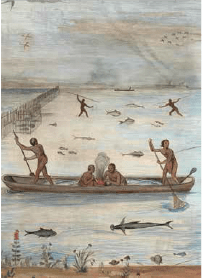Unit 2 • Lesson 8
The Woodland Period Part 2 – Late Woodland Period (1,000 to 400) years ago
8.2 – The Lenape
The Susquehannocks were the dominant Native American group in the lower Susquehanna River basin at the end of the Late Woodland Period 450 years ago. East of the Susquehanna basin, the Lenape people emerged as the dominant native group. The Lenape inhabited a large swath of territory known as “Lenapehoking,” which covered the Delaware River watershed in eastern Pennsylvania and Delaware, all of New Jersey, and portions of southern New York including the lower Hudson River Valley and Manhattan Island, where New York City is located.
The term Lenape will be used here to represent groups or bands of native people living in Lenapehoking near the end of the Late Woodland Period. Information you’ll learn about the Lenape is largely based on historical records from European observers and interpretations of the archaeological record.
Lenape people of Lenapehoking can be placed into two related but distinct groups. Each group was associated with a territorial landscape zone where a distinct dialect of the Delawarean language was spoken. (The Delawarean language was a branch of the Eastern Algonquian language family.) The physical boundaries of Lenapehoking’s dialect-based territories includes property extending from the coastline of the Atlantic Ocean west through New Jersey to the Delaware River watershed in Pennsylvania. Landscape features at points along the length of the Delaware River can be used to demarcate dialect territory boundaries. (See Lenapehoking-Lenape territories map.

Lenape is a term that is used to describe groups or bands of native people who spoke Munsee or Unami dialects and lived in Lenapehoking during the Late Woodland Period. Their descendants still are called Lenape. (State Museum of Pennsylvania)

Lenapehoking is a native name for the territory where Delawarean, an Algonquian-based language, was spoken around 400 years ago when European contact ended the Late Woodland Period. The Delawarean dialect of Munsee was reportedly spoken in the upper Delaware River watershed, to the Atlantic Coast at Sandy Hook, New Jersey, and northward. Another Delawarean dialect, Northern Unami, was spoken in the Middle Delaware, and Southern Unami was spoken in the Lower Delaware.
(JustinRayboun/adobestock.com)
• The Munsee dialect was spoken in the Upper Delaware River zone, from the Kittatinny Ridge and Delaware Water
Gap (DWG) north to the headwaters of the Delaware River in New York.
• People living in the Delaware River zone south of the DWG to Cape Henlopen, Delaware, spoke the Unami dialect.
• A variation of Unami dialect, known as the Northern Unami or Unalachtigo dialect, was spoken in the Middle
Delaware River portion, from the DWG to the Fall Line on the Delaware River.
• In the Lower Delaware River portion – Fall Line to Cape Henlopen – people spoke a southern Unami dialect variation.
Pottery Complexes of Lenapehoking
Pahaquarra Complex
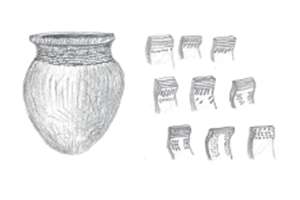
Minisink Complex
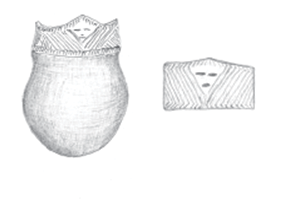
Overpeck Complex

Minguannan Complex
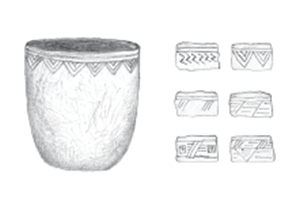
Several pottery complexes with distinct shapes
and designs have been associated with different
dialect groups and their related territories within
Lenapehoking. The Munsee of the Upper Delaware
are associated with Pahaquarra Complex pottery
and Minisink Complex pottery. The Unami of the
Middle Delaware are associated with Overpeck
Complex pottery. The Unami of the Lower Delaware
are associated with Minguannan Complex
pottery.(Adapted from Custer, 1996; Kraft, 2001)
The Lenape (pronounced Len-nah-pay in the Unami dialect and Len-nah-pew in the Munsee dialect) were descendants of earlier Algonquian-speaking ancestral or “proto” groups who occupied the region by the start of the Late Woodland Period 1,000 years ago. During the following 600-year period, these proto groups evolved into the Munsee- and Unami-speaking people who made first contact with various European groups who arrived in Lenapehoking ˜400 years ago.
The appearance of these proto groups and their time frame of existence are marked by distinct pottery styles (complexes) presumably manufactured by members of the groups. Proto-Munsee people have been associated with pottery of the Pahaquarra Somplex that was made from 1,000 to 700 years ago. Proto-Munsee and Munsee people also likely made Minisink Complex pottery from 600 to 400 years ago. Proto-Unami and Unami people of the mid-Delaware River zone have been connected with Overpeck Complex pottery made from 1,000 to 400 years ago. Proto-Unami and Unami of the Lower Delaware zone are thought to have produced Minguannan Complex pottery from 1,000 to 400 years ago.
Over time, these ancestral proto-groups who evolved culturally into Munsee- and Unami-speaking people, developed kinship groups. People speaking Munsee and Unami dialects may be viewed as being part of the Lenape “tribe.” Specifically they might be seen as being more closely connected by kinship as clan members within larger band groups who spoke similar, localized versions of either Munsee or Unami dialects.
Clans were associated with a phratry, which is an ancestral or kinship group affiliation. Based on historical accounts, Munsee and Unami phratry descent lines were matrilineal and traced through the mother’s side of a family. Phratries united clan members through a mythical belief that they had a distant common ancestor.
There were three main clan phratries in Munsee and Unami societies: the wolf, turtle, and turkey clan phratries. Within these three clans were 10 to 12 sub-clans, designated by a variety of names. Members of each clan were found throughout Lenapehoking, with a person’s clan membership being matrilineal and therefore the same as their mother’s clan. For example, if a mother belonged to the turtle clan, then each of her children also belonged to that clan and were considered related to every other person of the turtle phratry clan.
Lenape (Munsee and Unami) men were required to marry women from outside their own clan, a social practice known as exogamy. For example, if a male was a member of the turkey clan, he was expected to marry a female from either the turtle or wolf clans. His children would belong to their mother’s clan. Exogamy effectively prevented inbreeding within social groups.
Lenape families also practiced matrilocal residence, in which a married couple resided with the wife’s family. That meant daughters and sisters remained living near or in their mother’s dwelling. Sons left to marry and live with their wife’s clan while retaining a connection with their own clan membership. Matrilocal residence allowed for the formation of extended clan families, possibly with three or four generations living in the same place.
Clan mothers controlled their houses, families, child care, and education, as well as the distribution of inherited property and land territory rights. When formal leadership was needed, a female matriarch (grandmother or eldest woman) in consultation with other women clan elders, would appoint a sachem (chief or leader). Considered a wise person and good negotiator, the sachem (usually a man of the matriarch’s lineage) was advised by an informal council of elders when
making decisions. Archaeological evidence suggests that few Native Americans at this time lived beyond 35 years of age, so those able (and lucky enough) to reach an old age were greatly respected.
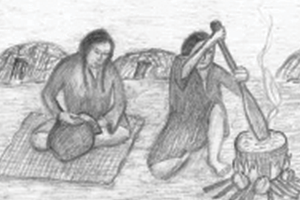
Lenape women made pottery from clay and also
wove other types of containers from plant materials.
All these vessels were important for storing and
cooking food, and transporting goods. These
tools and activities were an important part of the
Lenape economy and lifestyle. (Lance Leonhardt)
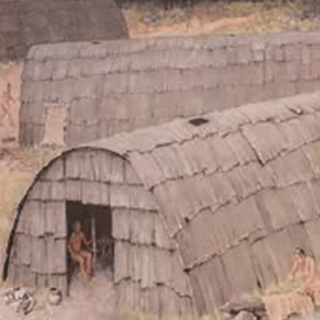
Lenape families practiced matrilocal residence,
in which a married couple resided with the wife’s family. Daughters and sisters lived near, or in, their mother’s dwelling. Three or four generations often resided in the same place. (State Museum of Pennsylvania)
A generalized Lenape lifestyle: Lenape women of all ages were an important part of their culture’s overall economy and were depended upon for gathering the majority of wild foods, cultivating domesticated crops, and making pottery. Economic importance may have been a contributing factor in the Lenape culture’s adoption of a matrilineal kinship system. (In contrast, some Native American cultures in which men, through hunting, provided the majority of food in their subsistence economy, often had a patrilineal kinship system. In these systems, kinship and residence are tied to the father’s side of family, as seen in patrilineal northern Algonquian groups where hunting was predominant.)Lenape women were involved in the production of a large portion of their community’s subsistence needs. They were in charge of planting and harvesting domesticated crops, gathering wild berries, roots and nuts, and processing and drying fish. They processed food by pounding and grinding seeds into flour, crushing and pressing nuts to squeeze out cooking oils, and drying crops or wild plant foods and fish for use in winter.
Women and children gathered firewood daily. Fire was critical for cooking, providing heat during winter, and hardening fired-clay pots women had skillfully made. Pottery was important for the cooking and storage of food. Women used plant materials to weave mats and baskets, construct containers, and braid cord to make rope and fish nets. Women gathered freshwater mussels from rivers, and oysters and clams from saltwater areas. They used bone and stone tools to scrape hair from animal hides, and then cut the hides into smaller sections and sewed them into clothes, moccasins, and shelter coverings using bone needles and animal sinew.

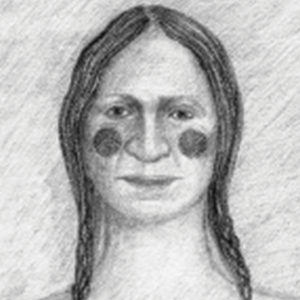
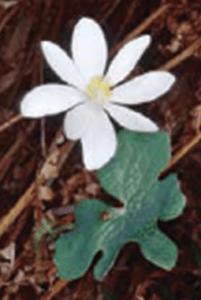
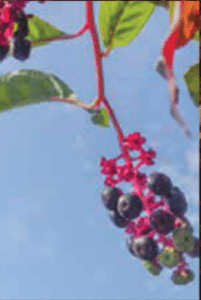
Lenape man and woman with facial decorations. Bloodroot (Sanguinaria canadensis), above left, and pokeberry (Phytolacca americana), far right, provided juices that were used to make a red dye for decorating the face, hair, and body. (Lance Leonhardt)

Woman scraping and smoothing an
animal hide in preparation of making clothing. (State Museum of Pennsylvania)
The average height for Lenape adults may have been about 5’8″ for men, and 5’3″ for women (based on skeletal remains of Woodland people living in southern Lenapehoking). Clothes worn on the body were made of soft hides from deer or beaver. In warmer weather, women wore short wrap-around skirts that often were painted with plant dyes and decorated with animal parts such as porcupine quills. Men wore loin cloths. In colder weather, both sexes might have worn deerskin moccasins and buckskin leggings tied with a belt. Other winter clothing may have included a heavy hide shirt, a fur robe made of beaver pelts or bearskin, fur mittens, and a cap. Women’s cloaks often were fashioned with iridescent wild turkey feathers.
Women wore their hair long, with headbands made from snakeskin, threaded shells, or strips of animal hide. Red paint made from the juice of plants such as bloodroot and pokeberry was mixed with bear grease and used for round decorative dots that were placed on womens’ cheeks. Men cut their hair or pulled it out, leaving only a small round clump on the top of the head, which they adorned with a feather or two. Both sexes applied bear grease (made from fat) to their heads, hair, and skin to make their bodies shine and protect themselves from biting insects. Lenape wore ornaments made from animal teeth and claws, shells, stone, feathers, and clay. Men tattooed themselves with images of birds, snakes and other animals, and geometric designs. They used bloodroot to dye deer hair red for headdresses and breast ornaments, and for painting chests and faces. Lenape people kept themselves clean by bathing in a stream or lake, or using a steam bath in a sweat lodge

Fish provided a reliable and substantial supply of meat to the Lenape diet. (Lance Leonhardt)
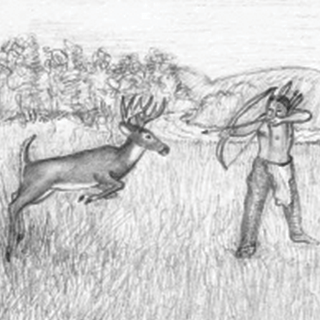
Lenape men hunted deer with bow and arrow to supply meat, hides for cloths, and antlers for tools.
(Lance Leonhardt)
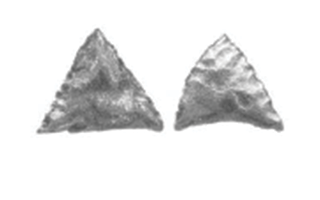
The triangle-shaped stone arrowhead (around one to two inches in height) was a common projectile point style of the Late Woodland.
Lenape men shared the work load with women. They used fire and axes to clear land for fields, and then broke up the soil for planting. They cut saplings with stone axes and used them to make framework posts for houses. Larger trees were selected for dugout canoes. Smaller, pliable saplings and branches were cut to construct weirs and large baskets to catch fish. Fishing was a very important source of food for the Lenape. They used techniques passed along by generations of people who lived along the Delaware River, Delaware Bay, and the Atlantic Ocean coastline. (See L7, Sidebar 1: Fishing, on page 172.)
Some men were skilled craftsmen who made bows and arrows, which were used extensively (along with distinctive triangular-shaped arrowheads) during the Late Woodland Period. (Note: As mentioned in Lesson 6, the bow and arrow may have been used by earlier, different cultures during the Archaic Period.)
Hunting and fishing were primarily responsibilities of Lenape men, but skilled women occasionally took part. Deer were often hunted by people who formed a large circle, and then used fire and loud noises to drive the animals into pens or rivers, where they could be killed easily. Traps, rope snares, and nets caught mammals such as raccoons, minks, beavers, otters, muskrats, and bobcats, as well as birds such as turkeys, passenger pigeons, ducks, and geese. Many of these animals also were
shot with arrows.
Lenape men were good warriors, and at times needed to defend their territories against outside groups such as the Iroquois to the north and the Susquehannocks to the west. Skirmishes among different rival Lenape groups in Lenapehoking probably occurred to a limited extent despite the Lenapes’ generally peaceful nature. According to historical accounts, numerous separate band groups with distinct identities occupied specific geographical territories in Lenapehoking prior to, and just after European arrival. A band group assigned parcels of land to particular clans for hunting, fishing, and cultivation, within the band’s overall territory. Private ownership of land was an unknown concept to the Lenape; land parcels belonged collectively to clans while they occupied it. Women had rights to certain family plots for gardening, or to sections of a waterway for fishing.
Clans lived at base settlements, which for much of the year were occupied mostly by women, children and elderly people who managed crops in surrounding fields, gathered wild plant foods, cooked and processed food, and made pottery and clothing. Men and skilled adolescents moved to seasonal campsites in surrounding communal areas to carry out specific tasks such as hunting and fishing, occasionally returning to their main (base) residential settlements with procured resources. In winter, some families may have resided in more sheltered upland sites. In spring, annual migrations of saltwater fish species into the Delaware River and its tributaries brought members of different bands together at places where fish concentrated and were plentiful.
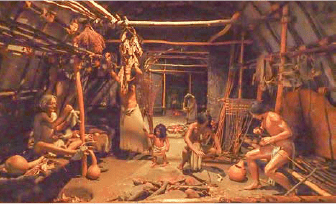
Inside a Lenape longhouse. A dirt floor was covered with mats. Platforms and shelves held sleeping berths and supplies. A fire pit hearth provided heat; an opening in the ceiling let out smoke. Corn hung from walls and storage pits were dug into the ground. Families living together in a household were usually related through the mother’s side of the family (a matrilineal kinship system). (State Museum of Pennsylvania)
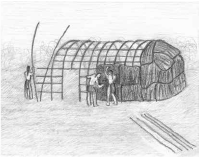
Men building a house placed cut tree saplings upright in the ground, bent them, lashed them together into a framework, and then covered theframework with bark shingles sliced from large, girdled trees. This basic construction method was used to build dwellings in sizes and shapes that best fit circumstances and seasons. (Lance Leonhardt)
Walls of the longhouse may have been decorated with mats. Storage pits for food were dug into the floor. Corn cobs hung from roof beams to dry. Building a longhouse required cooperation, communication, and coordination among all clan members.
Planting and tending crop fields also required concerted planning and cooperation. After slash-and-burn was used to clear land for a garden or field, women and children planted several kernels of eight-row corn in mounds that were about 15 feet wide and five feet apart. After corn sprouted and grew a short stalk, it was pushed up into a little hill, where beans were planted in the fresh soil. Squash and pumpkins (a type of squash) were planted between the large mounds of corn and beans. Beans and summer squash were harvested as they ripened; corn and pumpkins typically were harvested in late summer and fall.
Fertilizers weren’t used, so field soils were depleted within a few years. They were left fallow a while to regenerate fertility before being used again. If gardening or farming were to be practiced in a given
territory, it was important that enough good fields could be cleared to rotate fields adequately. Based on observations of Native American farmers in New England during the Contact Period, a one-acre field
could produce 40 bushels of corn, enough to feed five people for a year.
Using these values, if active crop fields of one to two acres in size were needed by each Lenape household, then dwellings in a multi-family community dispersed across a river valley could be spaced 500 feet (152 meters) or more apart. If a few residential structures were grouped and surrounded by cultivated fields, the distance between residential clusters would be even greater. Lenape hamlets or dispersed villages might have needed territory of at least 20 miles in diameter to provide enough area to rotate fields, hunt, fish, and, most importantly, collect enough firewood. Good, quality locations for crop fields would include flat, fertile soil sites near a water source, such as floodplain and terrace sites along rivers and larger streams.
Lifestyles varied in Lenapehoking – cultural and ecological influences: Many Lenape groups gardened or farmed corn; some did not. The importance of corn and the lifestyles required to produce it varied over time and location throughout Lenapehoking. The majority of sites where corn was grown tend to be focused in the upper and middle Delaware River Valley. Planting of corn appears to have taken place more in the upper Delaware; the practice of small-scale agriculture decreased toward southern Lenapehoking. Small-scale corn agriculture doesn’t appear to have taken hold in the lower Delaware.
Why did the use of corn in Lenapehoking vary among different Lenape groups? Why did people accept new, non-native plants such as corn, squash, and beans? And why did people engage in the traditional “Three Sisters” form of gardening and farming, especially in light of the increased effort needed to do so? Several interacting cultural and ecological factors are likely involved.
Corn may have arrived first in the upper Delaware ˜3,000 years ago, according to several Carbon-14 dates of corn ecofacts (charred kernels, starch residue, pollen grains) from a site near the mouth of Shohola Creek, a tributary of the Delaware River in Pike County, Pennsylvania. These are the earliest dates for corn in the Mid-Atlantic region of the United States, which includes Pennsylvania, Delaware, New Jersey, Maryland, and Virginia. Since corn reached the southwestern United States from Mexico only 4,000 years ago, the Shohola dates are controversial because they infer that people brought corn into the Mid-Atlantic sooner than previously thought. Corn ecofacts from other sites in the upper Delaware, which also underwent Carbon-14 testing, dated from ˜1,800 to 1,200 years ago. These ecofacts support the notion that corn was present in the Delaware River Valley by at least the Middle Woodland Period. Based on these and other dated specimens from the Northeast and Mid-Atlantic regions, it appears that the initial exposure to corn, or use of corn in the greater Delaware River watershed resulted from cultural interactions with native groups farther north in New York and
southern Ontario.

1. Shawnee-Minisink (PA) – Earliest, most significant excavation in Delaware Valley; Paleo-Indian to Late Woodland stratified site; Clovis fluted PP; hearths with ecofacts (seeds and fish bones) of Paleo-Indian diet
2. Nesquehoning (PA) – Paleo-Indian to Contact stratified site; fluted PP
3. Snyder Complex (NJ) – Paleo-Indian to Late Woodland stratified site; fluted PP
4. Treichler’s Bridge (PA) – Archaic to Late Woodland stratified site; 20,000 artifacts recovered; Early Archaic PP; Middle Archaic Bifurcate PP
5. Sandts Eddy (PA) – Archaic to Late Woodland stratified site; Middle Archaic bifurcate PP; plant processing tools
6. Padula (PA) – Late Archaic to Late Woodland; large upland base camp producing thousands of artifacts
7. Oberly Island (PA) – Archaic to Late Woodland; major base camp with large roasting features
8. Lower Black’s Eddy (PA) – Archaic to Late Woodland major base camp with FCR large roasting features. Site near argillite tool stone quarries.
9. Abbott Farm Complex (NJ) – Early Archaic to Late Woodland; Late Archaic to Woodland-FCR and large fishing camps; Middle Woodland pottery complex pottery
10. Faucett (PA) – Late Archaic to Late Woodland; multiple base camp occupations; large FCR features; broadspears; steatite bowl; net weights; bolo stones; Early Woodland Meadowood PPs
PP = projectile point
FCR = fire cracked rock
The pre-existing cultural practices of gardening and managing native wild plants may have allowed for easier acceptance of corn. Native Americans in the upper Delaware already had been altering and managing mast and native plants on upland and lowland sites long before nonnative corn, squash, and beans arrived. Pre-existing subsistence practices were already in place, possibly making the addition of new plants easier. Changes to existing methods may have been needed to add new plants to the list of native plants already being used. These changes probably happened as the new plants gained economic and social importance. Since the life cycle of non-native corn is different than the life cycles of native food plants of the Eastern Agricultural Complex, the integration and use of corn likely required some time before it could be used extensively. This may explain corn’s initially low levels of production. Reliance on a new plant probably was contingent on how easily it fit in with existing gardening and landscape management practices, and how well it grew in its new environment.
Initially, corn may have been grown as a curiosity or luxury food. Consumption may have been associated with special feasts and rituals that marked socially distinct events, or perhaps as memorials to past events. (Think of our use of pumpkin pie and cranberry sauce to commemorate Thanksgiving.) Corn may have been grown and traded by only a few groups.
By ˜1,100 to 1,000 years ago, corn was found all across the region, perhaps spreading from the upper Delaware into portions of the Susquehanna River Valley. An increase in the production and use of corn, along with other domesticated and wild plant foods in the upper Delaware, appears to have begun at the start of the Late Woodland Period. Archaeological studies of floodplain sediment layers in the upper Delaware River zone north of Delaware Water Gap reveal an increase in field soil sediment and corn plant ecofacts from ˜900 to 400 years ago. This suggests that bands of Munsee-speaking people living in the upper Delaware were clearing more forest for their settlements and fields in order to intensify their production of corn. Pottery fragments also were discovered in the sediments. The presence of pottery and corn together
suggests that Munsee people were occupying floodplains and farming on a semi-permanent or permanent basis.
The earliest and only date for squash’s appearance in Lenapehoking, again in the upper Delaware, is from ˜900 years ago, although squash has been dated much earlier in other areas of Pennsylvania. Domesticated beans appear to be in use ˜700 years ago, meaning that the traditional and nutritionally beneficial “Three Sisters” form of native farming wasn’t in place in Lenapehoking until then.
The arrival of Three Sisters agriculture in Lenapehoking also may have come from the north, where Munsee-speaking Lenape and Iroquoian-speaking cultures who utilized the practice, appear to have interacted. Similarities between Owasco pottery and proto-Munsee Pahaquarra pottery suggest some acculturation between the two groups took place. In Lenapehoking, Munsee speakers living in dispersed hamlets and villages in the upper Delaware River zone appear to have implemented more of a small-scale agriculturalist (AG) strategy (along with some hunting and collecting of fish and wild plants) than Unamispeaking groups in the middle and lower Delaware River zones.
